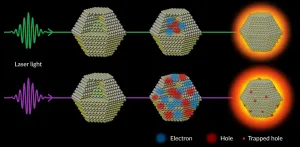(Press-News.org) Water scarcity in rural Alaska is not a new problem, but the situation is getting worse with climate change. Lasting solutions must encourage the use of alternative water supplies like rainwater catchment and grey water recycling. They must also address the affordability of water related to household income, say researchers from McGill University.
Washing hands with clean water is something most people take for granted, yet for Alaska's rural residents, this is often not the case. When people pay for water by the gallon, serious thought is given to how much is used - even during the COVID-19 pandemic.
In many rural Alaskan communities, where jobs are scarce and household income is low, the cost of water is a high burden, according to the study published in Environmental Management.
"Households in Anchorage paid nearly five dollars per 1000 gallons in 2017, while residents in more remote areas paid ten times as much," says co-author Antonia Sohns, a PhD Candidate under the supervision of McGill Professor Jan Adamowski.
Living on less than 6 liters of water a day
Due to the costliness of water and challenges accessing it, rural Alaskan homes without piped water use on average 5.7 liters of water per person per day - well below the World Health Organization standard of 20 liters per person per day, and far below the average of 110 liters per person per day in similar regions like Nunavut, Canada.
"As climate change manifests rapidly across the Arctic, the challenges that households face in securing sufficient water supplies for their daily needs becomes even more difficult," says Sohns.
Intensifying effects of climate change such as coastal erosion and storm surges are compromising water sources that communities depend on, leading to damaged infrastructure and saltwater intrusion into drinking water.
"Funding should be made available to address climate change impacts to water systems and to support adaptation strategies adopted by communities," says Adamowski of the Department of Bioresource Engineering.
Water quality, but not quantity?
Currently, there are no water quantity standards, but there are water quality standards. Changes to these regulations could strengthen access to water and improve the health of rural Alaskans.
According to the researchers, part of the solution could lie in promoting household-level approaches and changing how water is provided from conventional pipes to non-conventional systems. This includes increasing funding for alternative water systems, such as rainwater catchment or gray water recycling and reuse.
Although these solutions may not meet potable water standards at the state or federal level, they could significantly improve the quality of life in many communities, they say. Governments should consider reducing burdensome requirements to allow construction of less costly water systems on the way to a fully compliant system.
The researchers also note that infrastructure projects should consider community capacity, belief structure, and local preferences. Inadequate access to water is a persistent challenge in over 200 rural communities, whose residents are primarily Alaska Native people.
"We can't overlook the importance of different perceptions of water due to cultural preference. Many households continue to gather drinking water from sources that are culturally significant such as rivers, lakes, ice, or snowmelt. In considering such factors, approaches will be more long-lasting and resilient," says Sohns.
INFORMATION:
About this study
"Participatory Modeling of Water Vulnerability in Remote Alaskan Households Using Causal Loop Diagrams" by Antonia Sohns, James D. Ford, Jan Adamowski, and Brian E. Robinson was published in the January 2021 issue of Environmental Management.
DOI: https://doi.org/10.1007/s00267-020-01387-1
About McGill University
Founded in Montreal, Quebec, in 1821, McGill University is Canada's top ranked medical doctoral university. McGill is consistently ranked as one of the top universities, both nationally and internationally. It?is a world-renowned?institution of higher learning with research activities spanning two campuses, 11 faculties, 13 professional schools, 300 programs of study and over 40,000 students, including more than 10,200 graduate students. McGill attracts students from over 150 countries around the world, its 12,800 international students making up 31% of the student body. Over half of McGill students claim a first language other than English, including approximately 19% of our students who say French is their mother tongue.
https://www.mcgill.ca/newsroom/
A medical device that has been shown to manage pain among babies born preterm can also help keep their brain oxygen levels steady during medical procedures, finds new analysis by researchers at UBC.
The device, called Calmer, is a pillow-sized therapeutic bed covered in soft fabric and inserted into the incubator. It can be programmed to mimic a parent's heartbeat and breathing rate-- providing a soothing presence by moving up and down gently to simulate a breathing motion and heartbeat sound for the baby when their parent cannot be present.
"For newborns and particularly for preterm babies, it's critical to keep overall blood oxygen levels steady, especially in the brain. The more stable their brain oxygenation is, the better for their brain development," ...
Researchers at the Georgia Institute of Technology have uncovered an innovative way to tap into the over-capacity of 5G networks, turning them into "a wireless power grid" for powering Internet of Things (IoT) devices that today need batteries to operate.
The Georgia Tech inventors have developed a flexible Rotman lens-based rectifying antenna (rectenna) system capable, for the first time, of millimeter-wave harvesting in the 28-GHz band. (The Rotman lens is key for beamforming networks and is frequently used in radar surveillance systems to see targets in multiple directions without physically moving the antenna system.)
But to harvest enough power to supply low-power devices at long ranges, large aperture antennas are required. The problem with ...
Researchers at Baylor College of Medicine, Shandong University in China and other institutions may have found an explanation for dawn phenomenon, an abnormal increase of blood sugar only in the morning, observed in many patients with type 2 diabetes. They report in the journal Nature that mice lacking the circadian clock gene called Rev-erb in the brain show characteristics similar to those of dawn phenomenon.
The researchers then looked at Rev-erb gene expression in patients with type 2 diabetes comparing a group with dawn phenomenon to a group without it and found that the gene's expression followed a different temporal pattern between these two groups. The findings support the idea that an altered daily rhythm of expression of the Rev-erb gene may underlie dawn phenomenon. Future ...
WASHINGTON (March 25, 2021)--Although demand for COVID-19 vaccines currently seems high, vaccine hesitancy could pose a major threat to public health efforts to end the pandemic, according to an editorial published today in the journal Science.
The authors, including David A. Broniatowski, associate director of the George Washington University Institute for Data, Democracy & Politics, point out that public sentiment towards vaccines are volatile in the face of events such as the recent controversy surrounding the AstraZeneca vaccine clinical trial data. For example, some people could develop safety concerns due to the news reporting about the AstraZeneca vaccine and then turn down the chance to ...
Narcissism is driven by insecurity, and not an inflated sense of self, finds a new study by a team of psychology researchers. Its research, which offers a more detailed understanding of this long-examined phenomenon, may also explain what motivates the self-focused nature of social media activity.
"For a long time, it was unclear why narcissists engage in unpleasant behaviors, such as self-congratulation, as it actually makes others think less of them," explains Pascal Wallisch, a clinical associate professor in New York University's Department of Psychology and the senior author of the paper, which appears in the journal Personality and Individual Differences. "This has become quite prevalent in the age of social media--a behavior that's been coined 'flexing'.
"Our ...
A study by prof. Bas van Bavel and prof. Marten Scheffer shows that throughout history, most disasters and pandemics have boosted inequality instead of levelling it. Whether such disastrous events function as levellers or not, depends on the distribution of economic wealth and political leverage within a society at the moment of crisis. Their findings on the historical effects of crises on equality in societies are now published open access in Nature HSS Communications.
It is often thought that the main levellers of inequality in societies were natural disasters such as epidemics or earthquakes, and social turmoil such as wars and ...
CHAMPAIGN, Ill. -- Materials that contain special polymer molecules may someday be able to warn us when they are about to fail, researchers said. Engineers at the University of Illinois Urbana-Champaign have improved their previously developed force-sensitive molecules, called mechanophores, to produce reversible, rapid and vibrant color change when a force is applied.
The new study led by postdoctoral researcher Hai Qian, materials science and engineering professor and head Nancy Sottos, and Beckman Institute of Advanced Science and Technology director Jeffrey Moore is published in the journal Chem.
Moore's team has been working with mechanophores for more than a decade, but past efforts have produced molecules that were slow to react and return to their original state, if at all. ...
Bright semiconductor nanocrystals known as quantum dots give QLED TV screens their vibrant colors. But attempts to increase the intensity of that light generate heat instead, reducing the dots' light-producing efficiency.
A new study explains why, and the results have broad implications for developing future quantum and photonics technologies where light replaces electrons in computers and fluids in refrigerators, for example.
In a QLED TV screen, dots absorb blue light and turn it into green or red. At the low energies where TV screens operate, this conversion of light from one color to another is virtually 100% efficient. But at the higher excitation energies required for brighter screens and other ...
In the year since the coronavirus pandemic upended how just about every person on the planet interacts with one another, video conferencing has become the de facto tool for group collaboration within many organizations. The prevalent assumption is that technology that helps to mimic face-to-face interactions via a video camera will be most effective in achieving the same results, yet there's little data to actually back up this presumption. Now, a new study challenges this assumption and suggests that non-visual communication methods that better synchronize and boost audio cues are in fact more effective.
Synchrony Promotes Collective Intelligence
Researchers from Carnegie Mellon's Tepper School of Business and the Department of Communication at the University of California, Santa ...
Despite having remarkable utility in treating movement disorders such as Parkinson's disease, deep brain stimulation (DBS) has confounded researchers, with a general lack of understanding of why it works at some frequencies and does not at others. Now a University of Houston biomedical engineer is presenting evidence in Nature Communications Biology that electrical stimulation of the brain at higher frequencies (>100Hz) induces resonating waveforms which can successfully recalibrate dysfunctional circuits causing movement symptoms.
"We investigated the modulations in local ?eld potentials induced by electrical stimulation of the subthalamic nucleus (STN) at therapeutic and non-therapeutic frequencies in Parkinson's disease patients ...



